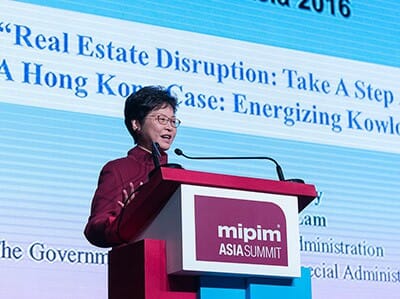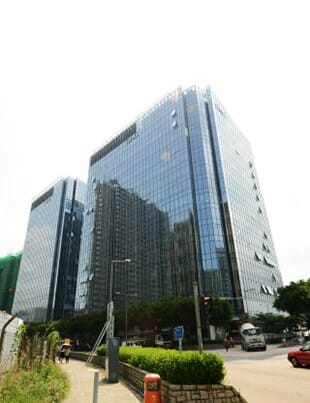
Carrie Lam delivering the keynote address at MIPIM Asia
More than $2.2 billion in commercial properties have changed hands in Hong Kong’s Kowloon East in the past year, and the city’s penultimate leader was quick to point out the government’s role in creating favourable conditions for this real estate bonanza in an address to global property investors last week.
Carrie Lam, Hong Kong’s Chief Secretary for Administration and the second-ranking official behind chief executive CY Leung, pointed out the success of Hong Kong’s Energising Kowloon East initiative in helping to lay the foundation for revitalizing the one-time industrial area around the former Kai Tak airport.
Delivering the keynote address at the MIPIM Asia conference in Hong Kong, Lam explained how the government’s Energizing Kowloon East Office (EKEO) works in tandem with private developers and the general public, while underlining the primacy of the private sector in the long-time bastion of free market policies.
Expanding the Government’s Role in Developing Hong Kong
“We have adopted a visionary approach with strong policy advocacy to develop the area, so we are no longer sitting back and just letting the private sector do the job – though it has been doing the job well,” Lam noted. “And I want to assure you that this advocacy, this strong integrated approach, does not mean we are not upholding the free market economy, we are very much so.”
In contrast to regional rival Singapore, where government authorities have traditionally taken the lead in planning for urban development and creating a sustainable city, Hong Kong officialdom has often been loathe to entangle itself in large-scale projects, apart from key infrastructure.
Lam indicated that times may be changing in freewheeling Hong Kong. “The time has come, in order to maintain Hong Kong’s global competitiveness, government has to be more proactive, we cannot just wait for the market to happen,” the career civil servant said.
Creating a Livable Business District in Kowloon East

The government initiative helped Wheelock sell One Harbourgate for more than $1.3 bil
As evidence that this new approach is working, Lam cited the 340 percent increase in overall office stock in Kowloon East over the last five years. Over the same period, new supply of office space in the city’s traditional downtown around Central has expanded by just four percent.
During the past year there has been a flurry of acquisitions and investments in the Kowloon East area, including developer Wheelock and Company selling off more than $1.3 billion in assets at its One Harbourgate complex to mainland investors. The local Hong Kong heavyweight came back for more land in the area last month, paying HK$6.39 billion ($824 million) for a 196,550-square-foot commercial site in Kwun Tong.
Kowloon East is also proving to be increasingly popular with multinational corporations looking for relief from Central’s world-leading office rental rates. JP Morgan opted for a Kowloon East location in November, agreeing to lease 225,000 square feet (20,900 square metres) at a project being co-developed by Link REIT and Nan Fung Development at 77 Hoi Bun Road.
Lam attributed these commercial achievements in part to the capacity of the EKEO to work closely with developers to help them best produce projects that fulfill their own strategies, while also aligning with the area’s redevelopment plans.
Lam expressed how it is only by having the trust of both private developers and the general public, that the government is able to take a visionary role in the transformation of the area. By backing plans to landscape and “beautify” the former factory district, including creating cycle lanes, pedestrian skywalks and communal areas, the government executive made a case for a new Hong Kong that is attractive to business and commercial investment by creating a more livable environment for its citizens.
Leave a Reply